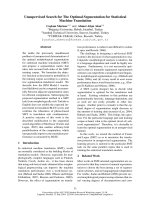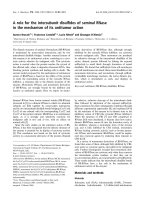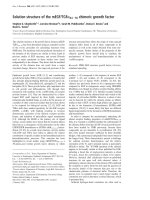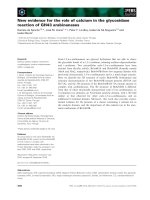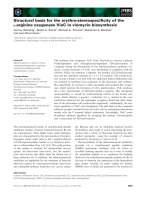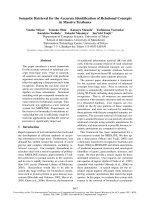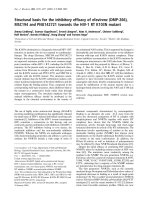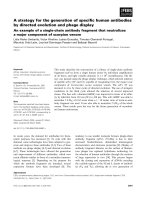Báo cáo sinh học: "Stage debut for the elusive Drosophila insulin-like growth factor binding proteins" potx
Bạn đang xem bản rút gọn của tài liệu. Xem và tải ngay bản đầy đủ của tài liệu tại đây (465.63 KB, 4 trang )
Minireview
SSttaaggee ddeebbuutt ffoorr tthhee eelluussiivvee
DDrroossoopphhiillaa
iinnssuulliinn lliikkee ggrroowwtthh ffaaccttoorr bbiinnddiinngg
pprrootteeiinn
Nazif Alic and Linda Partridge
Address: Institute of Healthy Ageing, GEE, University College London, Gower Street, London, WC1E 6BT, UK.
Correspondence: Linda Partridge. Email:
The first insect protein with the capacity to bind mammalian
insulin and insulin-like peptides had a serendipitous
discovery eight years ago. A 27 kDa protein from the fall
armyworm Spodoptera frugiperda was uncovered as an
insulin-binding activity in insect-cell-conditioned media
during attempts to purify fragments of the insulin receptor
from Sf9 cells [1]. The protein was purified and identified,
allowing subsequent identification of its single Drosophila
homolog, Imp-L2 [1]. In a recent study in Journal of Biology,
Honegger and coworkers [2] present the first, and long-
awaited, in vivo functional characterization of this insect
insulin/insulin-like growth factor (IGF) binding protein.
IInnssuulliinn//IIGGFF ssiiggnnaalliinngg aanndd IIGGFF bbiinnddiinngg pprrootteeiinnss
The insulin/IGF signaling (IIS) pathway is an evolutionarily
conserved neuroendocrine signaling pathway that regulates
a plethora of metazoan functions and traits, both during
development and in the adult. In model animals ranging
from the nematode worm and the fruit fly to the mouse, IIS
affects growth and development, metabolic/energy homeo-
stasis, stress resistance, reproduction and lifespan [3-5]. The
cellular IIS cascade is initiated by the extracellular binding
of an insulin/IGF-like ligand to an insulin-type receptor,
resulting in the activation of its intracellular tyrosine kinase
domain and the subsequent sequential activation of
phosphoinositide 3-kinase (PI 3-kinase) and protein kinase B
(Akt) and inactivation of the forkhead box-O transcription
factors [3,5]. The active receptor also activates the extra-
cellular signal-regulated kinase (Erk), and the Akt branch of
the pathway interacts with the target of rapamycin (TOR)
pathway [5].
Although there are numerous variants of the intracellular IIS
components in mammals, in invertebrates these are mainly
encoded by single genes. On the other hand, mammals
have only three ligands, insulin, IGF-I and IGF-II [5],
whereas there are 38 in the Caenorhabditis elegans genome
[6] and seven in Drosophila [7]. Dissecting the functions of
all these paralogs may give insights into how this pathway
regulates such diverse aspects of animal physiology.
Drosophila and other model organisms have provided
valuable insights into the mechanisms and effects of IIS.
However, an important aspect of the extracellular regulation
of the pathway has not been dissected in Drosophila: the
binding of ligands by extracellular binding proteins. In
mammals, IGF-I and IGF-II are bound in vivo by IGF
AAbbssttrraacctt
Insulin-like growth factor (IGF) binding proteins provide a layer of complexity to the
insulin/IGF signaling system in mammals, but only now, in a recent study in
Journal of Biology
,
has one such protein been functionally characterized in
Drosophila
.
BioMed Central
Journal of Biology
2008,
77::
18
Published: 7 July 2008
Journal of Biology
2008,
77::
18 (doi:10.1186/jbiol79)
The electronic version of this article is the complete one and can be
found online at />© 2008 BioMed Central Ltd
binding proteins (IGFBPs) [8]. The effects of IGFBPs on IIS
are complex. IGFBPs act as regulators of the activity of IGFs,
by prolonging their half-life, altering their local and systemic
availability and, through high-affinity binding, sequestering
them from the receptor [8,9]. Furthermore, at least some
IGFBPs appear to have IGF-independent functions [8].
Mammals have six IGFBPs that can bind IGFs with high
affinity, as well as several IGFBP-related proteins (IGFBP-rP)
with somewhat lower affinity for IGFs [9]. IGFBPs and
IGFBP-rPs belong to a protein superfamily sharing sequence
homology predominantly in their amino-terminal portion,
which is thought to be involved in IGF binding [9]. The
complexity of the IGF-IGFBP system and how it affects IIS has
not been examined in invertebrates because no orthologs of
IGFBP have been identified - that is, until recently.
IImmpp LL22:: tthhee
DDrroossoopphhiillaa
IIGGFFBBPP
IIS is an important regulator of growth, and overexpression
of the Drosophila insulin receptor in the eye during develop-
ment results in hyperplasia (overgrowth) of the eye. Honegger
and coworkers [2] used this phenotype, which had
previously been shown to be sensitive to the availability of
Drosophila insulin-like peptides (Dilps) [7], to screen for
negative regulators of IIS. The authors identified Imaginal
morphogenesis protein-Late 2 (Imp-L2) [10] as a strong
negative regulator of IIS.
The amino acid sequence of Imp-L2 indicates that it is a
secreted protein of the immunoglobulin superfamily [11],
with homologs in other invertebrates [1,2]. The carboxy-
terminal portion of Imp-L2 is similar to that of the human
IGFBP-rP1 (also known as IGFBP7 [9]; Figure 1), leading to
the exciting possibility that the screen might have identified
a fly IGFBP. Indeed, Imp-L2 had previously been shown to
bind human IGF-I, IGF-II and insulin in vitro with high
affinity [1], but its binding to Dilps and its potential role in
fly IIS had not been examined. Honegger and coworkers [2]
therefore set out to determine whether Imp-L2 is function-
ally equivalent to IGFBPs.
If Imp-L2 is a functional equivalent of IGFBP, it should
negatively regulate growth, and this effect should not be
restricted to the cells producing it but should be cell non-
autonomous. Indeed, Honegger and coworkers [2] found
that weak, ubiquitous overexpression of Imp-L2 yielded
smaller flies. When clones of cells in the Drosophila eye were
made to overexpress Imp-L2 in an otherwise wild-type fly,
their cell specification and patterning were not affected, but
the clones were small in size and this reduction also seemed
to affect the neighboring cells. Furthermore, overexpression
of Imp-L2 in the eye resulted not only in smaller eyes but
also in reduction in the size of the whole fly and a
developmental delay. Similarly, overexpression in the larval
fat body reduced the size of the whole organism. The latter
observation may, however, be confounded by the possi-
bility that fat-body-restricted downregulation of IIS could
affect energy homeostasis and thus organism growth.
Honegger and coworkers [2] also looked at the in vivo levels
of phosphatidylinositol (3,4,5)trisphosphate, the secondary
messenger produced by PI 3-kinase [5], and demonstrated
that, as would be expected of an IGFBP, Imp-L2 overexpression
can alter signaling downstream of the insulin receptor.
To further confirm Imp-L2 as a bona fide IGFBP equivalent,
Honegger et al. examined its interaction with Dilp2, the
most potent growth regulator of all the Dilps [12]. As
expected, Dilp2 and Imp-L2 were found to antagonize each
other genetically. Weak ubiquitous overexpression of Dilp2
during development caused a body and organ size increase
that was exacerbated in flies with only one copy of the Imp-
L2 gene. Strong overexpression of either Dilp2 or Imp-L2
alone resulted in lethality, but strong simultaneous overex-
pression of both allowed wild-type-sized flies to develop.
Furthermore, the authors showed that the Imp-L2 protein
can bind its native partner, Dilp2, in vitro.
FFuunnccttiioonnss ooff aann IIGGFFBBPP iinn fflliieess
The data presented by Honneger and coworkers [2] argue
strongly that Imp-L2 is functionally equivalent to mamma-
lian IGFBPs, opening the way to analysis of the functions of
this class of IIS regulators in flies. Indeed, the authors reveal
a role for Imp-L2 during fly development. Examination of
loss-of-function alleles showed that Imp-L2 is required for
body size determination during normal growth. Further-
more, Imp-L2 may be important under adverse nutritional
conditions. Imp-L2 was induced in the fat body when larvae
were starved and loss of Imp-L2 function resulted in a failure
to decrease IIS and caused starvation-sensitivity.
A detailed examination of the role of Imp-L2 in adult
physiology has yet to be made, but some hints exist as to
the function of this protein in the adult. When the germline
is ablated late in development, fly lifespan is extended [13].
Concomitantly, the Imp-L2 transcript is upregulated [13],
indicating that Imp-L2 may be part of a gonad-derived
signaling that modulates whole-body IIS.
RReesseeaarrcchh aavveennuueess ooppeenneedd uupp bbyy IImmpp LL22
It will be important to establish the similarities and
differences between the mammalian IGF-IGFBP system and
the Drosophila Dilp-Imp-L2 system. Characterization of the
Dilps at the protein level, and of whether and how they
18.2
Journal of Biology
2008, Volume 7, Article 18 Alic and Partridge />Journal of Biology
2008,
77::
18
form complexes with Imp-L2, will be important. It is
interesting in this respect that the homology between
IGFBP-rP1 and Imp-L2 does not extend into the amino-
terminal, IGFBP-like portion of IGFBP-rP1 (see Figure 1),
thought to be required for IGF and insulin binding [9,14]. It
will be important to determine functional similarities
between Imp-L2 and IGFBP-rP1, especially now that the
importance of IGFBP-rP1 as a tumor suppressor has been
highlighted [15,16]. Furthermore, it may be interesting to
determine whether Imp-L2, like some IGFBPs, has functions
independent of Dilp binding, opening up the possibility of
using Drosophila to understand how these ligand-inde-
pendent functions are effected. It will also be interesting to
examine whether Imp-L2, like mammalian IGFBPs [8,9],
can act both locally and systemically and whether its activity
is regulated by proteolysis. A similarity to the mammalian
system, in which most IGF-I or IGF-II circulates as part of
ternary complexes of IGF, IGFBP3 and the acid-labile
subunit (ALS) [8], was uncovered by the recent
characterization of the Drosophila ALS [17], which appears
to form a trimeric complex with Dilp2 and Imp-L2.
The number of questions that remain only demonstrates
how important the work by Honneger and coworkers [2]
has been in opening up the field of study of IGFBP in
Drosophila. The study of Imp-L2 in such a genetically
amenable system will surely yield results relevant to the
understanding of mammalian IGFBPs.
AAcckknnoowwlleeddggeemmeennttss
We acknowledge funding by the Wellcome Trust (LP) and a Marie
Curie Fellowship (NA). We thank Iain Robinson for critically reading
the manuscript.
RReeffeerreenncceess
1. Sloth Andersen A, Hertz Hansen P, Schaffer L, Kristensen C:
AA
nneeww sseeccrreetteedd iinnsseecctt pprrootteeiinn bbeelloonnggiinngg ttoo tthhee iimmmmuunnoogglloobbuulliinn
ssuuppeerrffaammiillyy bbiinnddss iinnssuulliinn aanndd rreellaatteedd ppeeppttiiddeess aanndd iinnhhiibbiittss tthheeiirr
aaccttiivviittiieess
J Biol Chem
2000,
227755::
16948-16953.
2. Honegger B, Galic M, Kohler K, Wittwer F, Brogiolo W, Hafen E,
Stocker H:
IImmpp LL22,, aa ppuuttaattiivvee hhoommoolloogg ooff vveerrtteebbrraattee IIGGFF bbiinnddiinngg
pprrootteeiinn 77,, ccoouunntteerraaccttss iinnssuulliinn ssiiggnnaalliinngg iinn
DDrroossoopphhiillaa
aanndd iiss eesssseenn
ttiiaall ffoorr ssttaarrvvaattiioonn rreessiissttaannccee
J Biol
2008,
77::
10.
3. Piper MD, Selman C, McElwee JJ, Partridge L:
SSeeppaarraattiinngg ccaauussee
ffrroomm eeffffeecctt:: hhooww ddooeess iinnssuulliinn//IIGGFF ssiiggnnaalllliinngg ccoonnttrrooll lliiffeessppaann iinn
wwoorrmmss,, fflliieess aanndd mmiiccee??
J Intern Med
2008,
226633::
179-191.
4. Edgar BA:
HHooww fflliieess ggeett tthheeiirr ssiizzee:: ggeenneettiiccss mmeeeettss pphhyyssiioollooggyy
Nat
Rev Genet
2006,
77::
907-916.
5. White MF:
RReegguullaattiinngg iinnssuulliinn ssiiggnnaalliinngg aanndd bbeettaa cceellll ffuunnccttiioonn
tthhrroouugghh IIRRSS pprrootteeiinnss
Can J Physiol Pharmacol
2006,
8844::
725-737.
6. Pierce SB, Costa M, Wisotzkey R, Devadhar S, Homburger SA,
Buchman AR, Ferguson KC, Heller J, Platt DM, Pasquinelli AA, Liu
LX, Doberstein SK, Ruvkun G:
RReegguullaattiioonn ooff DDAAFF 22 rreecceeppttoorr ssiigg
nnaalliinngg bbyy hhuummaann iinnssuulliinn aanndd iinnss 11,, aa mmeemmbbeerr ooff tthhee uunnuussuuaal
lllyy llaarrggee
aanndd ddiivveerrssee
CC eelleeggaannss
iinnssuulliinn ggeennee ffaammiillyy
Genes Dev
2001,
1155::
672-686.
7. Brogiolo W, Stocker H, Ikeya T, Rintelen F, Fernandez R, Hafen E:
AAnn eevvoolluuttiioonnaarriillyy ccoonnsseerrvveedd ffuunnccttiioonn ooff tthhee
DDrroossoopphhiillaa
iinnssuulliinn
rreecceeppttoorr aanndd iinnssuulliinn lliikkee ppeeppttiiddeess iinn ggrroowwtthh ccoonnttrrooll
Curr Biol
2001,
1111::
213-221.
8. Mohan S, Baylink DJ:
IIGGFF bbiinnddiinngg pprrootteeiinnss aarree mmuullttiiffuunnccttiioonnaall aanndd
aacctt vviiaa IIGGFF ddeeppeennddeenntt aanndd iinnddeeppeennddeenntt mmeecchhaanniissm
mss
J Endocrinol
2002,
117755::
19-31.
9. Hwa V, Oh Y, Rosenfeld RG:
TThhee iinnssuulliinn lliikkee ggrroowwtthh ffaaccttoorr
bbiinnddiinngg pprrootteeiinn ((IIGGFFBBPP)) ssuuppeerrffaammiillyy
Endocr Rev
1999,
2200::
761-787.
/>Journal of Biology
2008, Volume 7, Article 18 Alic and Partridge 18.3
Journal of Biology
2008,
77::
18
FFiigguurree 11
Sequence comparison of Imp-L2, its invertebrate homologs, and IGFBP-rP1. The sequences of Imp-L2 (
Drosophila
), Insulin-related peptide binding
protein (IBP;
S. frugiperda
), ZIG-4 (
C. elegans
) and IGFBP-rP1 (human) were aligned using ClustalW2 [18]. Residues identical or similar in at least
three sequences are highlighted in black and gray, respectively. Asterisks below the sequence show the cysteines thought to form two disulfide
bridges. The two immunoglobulin-like domains are indicated by a gray bar and the region in IGFBP-rP1 that has the most similarity to IGFBPs by a
black bar below the sequences. The annotation was adapted from [2,9].
10. Osterbur DL, Fristrom DK, Natzle JE, Tojo SJ, Fristrom JW:
GGeenneess eexxpprreesssseedd dduurriinngg iimmaaggiinnaall ddiissccss mmoorrpphhooggeenneessiiss:: IIMMPP LL22,, aa
ggeennee eexxpprreesssseedd dduurriinngg iimmaaggiinnaall ddiisscc aanndd iimmaaggiinnaall hhiissttoobbllaasstt mmoorr
pphhooggeenneessiiss
Dev Biol
1988,
112299::
439-448.
11. Garbe JC, Yang E, Fristrom JW:
IIMMPP LL22:: aann eesssseennttiiaall sseeccrreetteedd
iimmmmuunnoogglloobbuulliinn ffaammiillyy mmeemmbbeerr iimmpplliiccaatteedd iinn nneeuurraall aanndd eeccttooddeerr
mmaall ddeevveellooppmmeenntt iinn
DDrroossoopphhiillaa
Development
1993,
111199::
1237-
1250.
12. Ikeya T, Galic M, Belawat P, Nairz K, Hafen E:
NNuuttrriieenntt ddeeppeennddeenntt
eexxpprreessssiioonn ooff iinnssuulliinn lliikkee ppeeppttiiddeess ffrroomm nneeuurrooeennddooccrriinnee cceellllss iinn
tthhee CCNNSS ccoonnttrriibbuutteess ttoo ggrroowwtthh rreegguullaattiioonn iinn
DDrroossoopphhiillaa
Curr
Biol
2002,
1122::
1293-1300.
13. Flatt T, Min KJ, D’Alterio C, Villa-Cuesta E, Cumbers J, Lehmann
R, Jones DL, Tatar M:
DDrroossoopphhiillaa
ggeerrmm lliinnee mmoodduullaattiioonn ooff iinnssuulliinn
ssiiggnnaalliinngg aanndd lliiffeessppaann
Proc Natl Acad Sci USA
2008,
110055::
6368-
6373.
14. Yamanaka Y, Wilson EM, Rosenfeld RG, Oh Y:
IInnhhiibbiittiioonn ooff iinnssuulliinn
rreecceeppttoorr aaccttiivvaattiioonn bbyy iinnssuulliinn lliikkee ggrroowwtthh ffaaccttoorr bbiinnddiinngg pprrootteeiinnss
J
Biol Chem
1997,
227722::
30729-30734.
15. Wajapeyee N, Serra RW, Zhu X, Mahalingam M, Green MR:
OOnnccooggeenniicc BBRRAAFF iinndduucceess sseenneesscceennccee aanndd aappooppttoossiiss tthhrroouugghh ppaatthh
wwaayyss mmeeddiiaatteedd bbyy tthhee sseeccrreetteedd pprrootteeiinn IIGGFFBBPP77
.
Cell
2008,
113322::
363-374.
16. Burger AM, Leyland-Jones B, Banerjee K, Spyropoulos DD, Seth
AK:
EEsssseennttiiaall rroolleess ooff IIGGFFBBPP 33 aanndd IIGGFFBBPP rrPP11 iinn bbrreeaasstt ccaanncceerr
Eur
J Cancer
2005,
4411::
1515-1527.
17. Arquier N, Geminard C, Bourouis M, Jarretou G, Honegger B,
Paix A, Leopold P:
DDrroossoopphhiillaa
AALLSS rreegguullaatteess ggrroowwtthh aanndd mmeettaabboo
lliissmm tthhrroouugghh ffuunnccttiioonnaall iinntteerraaccttiioonn wwiitthh iinnssuulliinn lliikkee ppeeppttiiddeess
Cell
Metab
2008,
77::
333-338.
18. Larkin MA, Blackshields G, Brown NP, Chenna R, McGettigan PA,
McWilliam H, Valentin F, Wallace IM, Wilm A, Lopez R, Thomp-
son JD, Gibson TJ, Higgins DG:
CClluussttaall WW aanndd CClluussttaall XX vveerrssiioonn
22 00
.
Bioinformatics
2007,
2233::
2947-2948.
18.4
Journal of Biology
2008, Volume 7, Article 18 Alic and Partridge />Journal of Biology
2008,
77::
18
